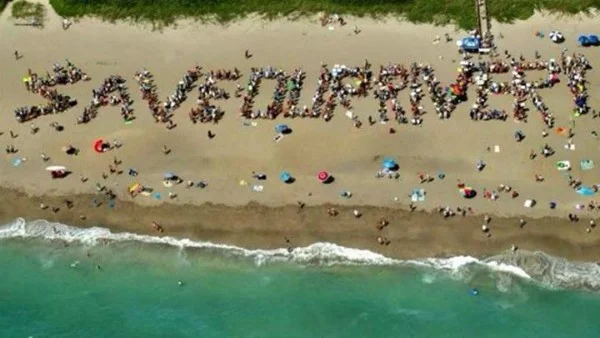Major Progress Being Made for Florida Rivers

A much-needed reservoir is one step closer to construction with the Army Corps of Engineers and White House Office of Management and Budgeting approving the $1.4 billion project to limit toxic discharges from Lake Okeechobee. After decades of destruction to Florida waterways, crucial restoration plans are moving forward with the green light from congress.
Water from Lake Okeechobee, which is currently 90 percent covered in cyanobacteria according to the National Oceanic and Atmospheric Administration, gets pumped east and west into the St. Lucie and Caloosahatchee Rivers nearly every day during the rainy season when the one trillion-gallon lake can’t hold anymore. The bacteria infested water then travels through these rivers picking up runoff from septic tanks and farming pesticides along the way, which combined with mixed salinity differences, can cause the cyanobacteria to bloom into blue-green algae. This foul-smelling sludge of toxic algae rapidly proliferates in Florida’s warm waters, making them look and feel more like a can of Shamrock-colored paint, suffocating marine life and causing respiratory and neurological issues for anyone near it too long.
Aside from being a health hazard to many species and ruining the state’s most beautiful asset, the algae affects businesses, real estate and tourism, losing millions each year. The “toxic summer” of 2013 when blue-green algae covered Stuart’s waters resulted in a $488 million reduction in Martin County’s total property value, according to a Florida Association of Realtors study. News coverage of the blooms sent a wave of disgust beyond Florida’s borders, resulting in tourism and home sale losses, but was the push legislatures needed to expedite restoration plans.
Florida’s natural flow of water is south to the Everglades, not east and west how the discharges are pumped now. The reason it isn’t currently pumped south is because that land is privately owned by U.S. Sugar, and hundreds of miles of sugar cane plants are grown there. Many clean water advocates have protested to restore the natural flow of water with little concern for the sugar industry, as their fields have cut the Everglades off from its natural water supply and the system is suffering because of it. But sugar is one of Florida’s top exports, generating $3.2 billion for the state’s economy each year. For that reason, democrats and republicans have been at odds about where and how to store excess water, taking years to implement anything. Now, finally coming together with a plan, a proposal to build an above-ground reservoir south of the lake has made it up the ladder into approval.
A 23-foot-deep, 17,000-acre reservoir will store, filter and clean 78.2 billion gallons of overflow water from Lake Okeechobee. It will reduce discharges by 63 percent and send 120.6 billion gallons to the Everglades, according to a Nature Conservancy Organization release. This will help Florida’s east and west coast rivers go back to being clear, beautiful and flourishing with marine life and sea grass like it was before the overwhelming discharges of pollution. This is great news for the 19 counties and 164 municipalities in Florida affected by the health of the Everglades System, which runs from Lake Okeechobee to the Florida Bay by the Keys. The long battle over conservancy has resulted in a hopeful solution; the fish can flourish in clean waters, residents have a place to enjoy water activities, businesses like kayak rental companies can attract customers again and property values will rise more than ever before with crystal clear waters in their backyards.
The project is getting started now with 50 percent of the money available, and small pieces of land have already been purchased. It’s estimated to take anywhere from 7-9 years to complete the 10,500-acre reservoir and 6,500 treatment marsh to filter. For now, other restoration projects are underway and the Army Corps of Engineers has tried a “pulsing” discharge tactic where they pump small amounts of water out of the lake before it gets too full when there’s heavy rainfall.
Those who haven’t made investments in homes or businesses because of potential algae blooms, or those hesitant to list their homes because of it, can be relieved of fears now that the ball is rolling on plans. And since the housing market has been steadily improving, now is a great time to invest in a waterfront property to enjoy for a lifetime, as the water quality will also only continue to improve.
Contact Martin County real estate expert Adam Brown for more information on how the reservoir will help the St. Lucie River and increase property values in the area. See more about Waterfront Properties & Club Communities here and check out listings in Martin County by clicking here.
Pictured above: Stuart area residents gathered on the beach during summer 2016 when bacteria prevented anyone from swimming in certain parts of the Intracoastal. The event was organized by Citizens for Clean Water, a non-profit formed in 2013.



Leave A Comment